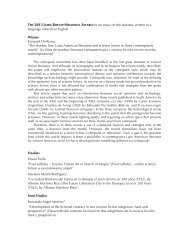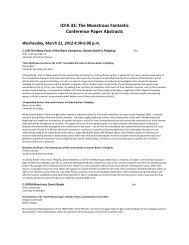The Uncanny and Monstrosity: Still More on the Tropology of SF
The Uncanny and Monstrosity: Still More on the Tropology of SF
The Uncanny and Monstrosity: Still More on the Tropology of SF
You also want an ePaper? Increase the reach of your titles
YUMPU automatically turns print PDFs into web optimized ePapers that Google loves.
Let me be clear in saying I invoke Freud not as a psychologist but as a <strong>the</strong>orist <strong>of</strong><br />
narrative; when I use his terms, I’m not referring to psychological states but <strong>on</strong>ly to<br />
narrative devices—just tropes, <str<strong>on</strong>g>and</str<strong>on</strong>g> <strong>the</strong>y w<strong>on</strong>’t bite you, ok? Published in 1919 (when<br />
Freud was 63), "Das Unheimliche" examines "that class <strong>of</strong> <strong>the</strong> frightening which leads<br />
back to what is known <strong>of</strong> old <str<strong>on</strong>g>and</str<strong>on</strong>g> l<strong>on</strong>g familiar" (220). <str<strong>on</strong>g>The</str<strong>on</strong>g> "uncanny" is <strong>the</strong><br />
displacement or ir<strong>on</strong>ized inversi<strong>on</strong> <strong>of</strong> <strong>the</strong> familiar (<strong>the</strong> homely, domestic, evident) <str<strong>on</strong>g>and</str<strong>on</strong>g><br />
<strong>the</strong> unfamiliar (<strong>the</strong> foreign, alien, occult). What most interests Freud—<str<strong>on</strong>g>and</str<strong>on</strong>g> us—is that<br />
"heimlich...comes to be unheimlich," that <strong>the</strong> single word signifies two very different but<br />
not altoge<strong>the</strong>r c<strong>on</strong>tradictory things: "<strong>on</strong> <strong>the</strong> <strong>on</strong>e h<str<strong>on</strong>g>and</str<strong>on</strong>g> it means what is familiar <str<strong>on</strong>g>and</str<strong>on</strong>g><br />
agreeable, <str<strong>on</strong>g>and</str<strong>on</strong>g> <strong>on</strong> <strong>the</strong> o<strong>the</strong>r, what is c<strong>on</strong>cealed <str<strong>on</strong>g>and</str<strong>on</strong>g> kept out <strong>of</strong> sight" (224-25). Freud's<br />
discovery is that "heimlich is a word <strong>the</strong> meaning <strong>of</strong> which develops in <strong>the</strong> directi<strong>on</strong> <strong>of</strong><br />
ambivalence, until it finally coincides with its opposite, unheimlich" (226). When <strong>the</strong><br />
feeling <strong>of</strong> bel<strong>on</strong>ging becomes estranged, alienated, or displaced <strong>on</strong>to <strong>the</strong> alien, it results<br />
in <strong>the</strong> uncanny. And vice versa, when <strong>the</strong> alien is domesticated. Uncanniness can<br />
occur <strong>on</strong>ly in <strong>the</strong> recurrence <strong>of</strong> "discarded belief" (248), <str<strong>on</strong>g>and</str<strong>on</strong>g> so <strong>on</strong>ly those beliefs<br />
repressed (not refuted or discredited) from c<strong>on</strong>scious thought can return to evoke<br />
m<strong>on</strong>strosity—uncanny dread, fear, or loathing. Here, repressi<strong>on</strong> is to be understood in<br />
its strict psychoanalytic sense, for Freud will exploit <strong>the</strong> fact that in German, unheimlich<br />
also means "c<strong>on</strong>cealed, kept from sight, so that o<strong>the</strong>rs do not get to know <strong>of</strong> or about it,<br />
withheld from o<strong>the</strong>rs" (223).<br />
Freud closely studies several textual examples, most notably E.A. H<strong>of</strong>fmann's<br />
tale "<str<strong>on</strong>g>The</str<strong>on</strong>g> S<str<strong>on</strong>g>and</str<strong>on</strong>g>-Man," his novel <str<strong>on</strong>g>The</str<strong>on</strong>g> Devil's Elixir, <str<strong>on</strong>g>and</str<strong>on</strong>g> Friedrich v<strong>on</strong> Schiller's poem<br />
"<str<strong>on</strong>g>The</str<strong>on</strong>g> Ring <strong>of</strong> Polycrates." <str<strong>on</strong>g>The</str<strong>on</strong>g> uncanny problematics <strong>of</strong> <strong>the</strong>se texts "are all c<strong>on</strong>cerned<br />
with <strong>the</strong> phenomen<strong>on</strong> <strong>of</strong> <strong>the</strong> 'double'" (234); in every instance, <strong>the</strong> "extraneous" double<br />
repeats features <strong>of</strong> <strong>the</strong> protag<strong>on</strong>ist's life, creating a certain ambiguity between self <str<strong>on</strong>g>and</str<strong>on</strong>g><br />
o<strong>the</strong>r, original <str<strong>on</strong>g>and</str<strong>on</strong>g> copy, primal event <str<strong>on</strong>g>and</str<strong>on</strong>g> psychic repetiti<strong>on</strong>. After tracing "<strong>the</strong> manifest"<br />
meaning <strong>of</strong> doubling within psychoanalytic interpretati<strong>on</strong>, Freud goes <strong>on</strong> to identify its<br />
specific functi<strong>on</strong> in creating uncanny dread: it is "<strong>the</strong> repetiti<strong>on</strong> <strong>of</strong> <strong>the</strong> same" (236), <strong>of</strong><br />
"involuntary repetiti<strong>on</strong>" (237) that uniquely marks <strong>the</strong> unheimlichkeit. How "involuntary<br />
repetiti<strong>on</strong>" determines <strong>the</strong> uncanny derives from "infantile psychology," which becomes<br />
a mechanism as familiar as <strong>the</strong> uncanny itself: "<strong>the</strong> compulsi<strong>on</strong> to repeat" (234). Four<br />
pages <strong>of</strong> "Das Unheimliche" (234-38) c<strong>on</strong>dense <str<strong>on</strong>g>and</str<strong>on</strong>g> repeat <strong>the</strong> larger argument,<br />
displaced from Bey<strong>on</strong>d <strong>the</strong> Pleasure Principle.<br />
In psychoanalytic thought (ei<strong>the</strong>r in Freud or Lacan), <strong>the</strong> circuit <strong>of</strong> desire is<br />
irremediably (ineluctably?) linked to repetiti<strong>on</strong>, for it is <strong>on</strong>ly in <strong>the</strong> repetiti<strong>on</strong> <strong>of</strong> Oedipal<br />
triangles that desire structures itself; <str<strong>on</strong>g>and</str<strong>on</strong>g> it is <strong>on</strong>ly <strong>the</strong> repetiti<strong>on</strong> <strong>of</strong> desire that structures<br />
<strong>the</strong> need for repressi<strong>on</strong>—an originating gesture that opens <strong>the</strong> unc<strong>on</strong>scious; <str<strong>on</strong>g>and</str<strong>on</strong>g> <strong>on</strong>ly in<br />
repetiti<strong>on</strong>/recovery <strong>of</strong> <strong>the</strong> repressed can desire be realized or relieved. Bey<strong>on</strong>d <strong>the</strong><br />
Pleasure Principle traces that "infantile psychology." <str<strong>on</strong>g>The</str<strong>on</strong>g> general structure <strong>of</strong> <strong>the</strong><br />
repetiti<strong>on</strong> compulsi<strong>on</strong> can be understood in <strong>the</strong> child's pleasure in playing <strong>the</strong> fort/da<br />
game with an empty wooden spool. It is a staged repetiti<strong>on</strong> <strong>of</strong> <strong>the</strong> mo<strong>the</strong>r's coming <str<strong>on</strong>g>and</str<strong>on</strong>g><br />
going. First g<strong>on</strong>e (fort) <strong>the</strong>n here (da), <strong>the</strong> spool vanishes <str<strong>on</strong>g>and</str<strong>on</strong>g> returns—a yo-yo pattern<br />
that precisely doubles <strong>the</strong> mo<strong>the</strong>r's appearance <str<strong>on</strong>g>and</str<strong>on</strong>g> disappearance—<str<strong>on</strong>g>and</str<strong>on</strong>g> both events<br />
are delightfully exclaimed to any <strong>on</strong>looker. Where desire—following Barbara Johns<strong>on</strong>'s<br />
analogy—"is located 'in' a symbolic structure, a structure that can <strong>on</strong>ly be perceived in<br />
its effects, <str<strong>on</strong>g>and</str<strong>on</strong>g> whose effects are perceived as repetiti<strong>on</strong>" (141), Freud identifies <strong>the</strong>





